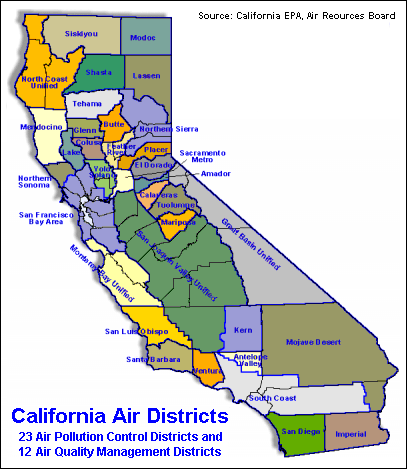California Air Resources Board
The California Air Resources Board, also known as (CARB) is the "clean air agency" in the government of California. CARB was formed in 1967 by combining the Bureau of Air Sanitation and the Motor Vehicle Pollution Control Board and it is a department within the California Environmental Protection Agency.[1]
The stated goals of CARB include attaining and maintaining healthy air quality, protecting the public from exposure to toxic air contaminants and providing innovative approaches for complying with national and state air pollution control rules and regulations.
Governance
CARB is governed by a board made up of eleven members appointed by the state's governor.[2]
Five of the members represent the 35 regional air quality control districts in California:
- One from the South Coast Air Quality Management District (Greater Los Angeles Region)
- One from the San Francisco Bay Area Air Quality Management District
- One from the San Diego Air Pollution Control District
- One from the San Joaquin Valley Unified Air Pollution Control District
- One from any other air pollution control district within California
Three of the members must fit into specific categories:
- One having expertise in automotive engineering or a closely related field.
- One having expertise in science, agriculture, or law.
- One being a physician or health effects expert.
The remaining three members are public members, one of whom must have air pollution control experience or fit into one of the above three specific categories.
CARB's Organizational Structure
CARB has nine major Divisions:[3]
- Administrative Services Division
- Enforcement Division
- Mobile Source Control Division
- Mobile Source Operations Division
- Monitoring and Laboratory Division
- Office of Information Services
- Planning and Technical Support Division
- Research Division
- Stationary Source Division
Planning and Technical Support Division
The Planning and Technical Support Division assesses the extent of California's air quality problems and the progress being made to abate them, coordinates statewide development of clean air plans and maintains databases pertinent to air quality and emissions. The Division's technical support work provides a basis for clean air plans and CARB's regulatory programs. This support includes management and interpretation of emission inventories, air quality data, meteorological data and of air pollution dispersion modeling.
The Planning and Technical Support Division has five branches:[4]
- Emission Inventory Branch
- Modeling & Meteorology Branch
- Air Quality Data Branch
- Air Quality & Transportation Planning Branch
- Mobile Source Analysis Branch
Atmospheric Modeling & Support Section
The Atmospheric Modeling & Support Section is one of three sections within the Modeling & Meteorology Branch. The other two sections are the Regional Air Quality Modeling Section and the Meteorology Section.[4]
The air quality and atmospheric pollution dispersion models[5][6] routinely used by this Section include a number of the models recommended by the U.S. EPA:[7]
- AERMOD: Maintained by the U.S. EPA and available from their website.[8]
- SCREEN3 and T-SCREEN screening models: Maintained by the U.S. EPA and available from their website.[8]
- ISCST3: Maintained by the U.S. EPA and available from their website.[8]
The Section also uses models which were either developed by CARB or whose development was funded by CARB, such as:[7]
- CALPUFF: Development funded by CARB. Currently maintained by TRC Companies.[9]
- CALINE-4: Maintained by the California Department of Transportation (Caltrans) and available from their website.[10]
- CALGRID: Developed by CARB and currently maintained by CARB.[11]
- SARMAP: Developed by CARB and currently maintained by CARB.[12]
References
- ↑ A brief history of the ARB
- ↑ Selection of CARB's Board
- ↑ CARB's Divisions
- ↑ 4.0 4.1 Planning and Technical Support Division
- ↑ Turner, D.B. (1994). Workbook of atmospheric dispersion estimates: an introduction to dispersion modeling, 2nd Edition. CRC Press. ISBN 1-56670-023-X. www.crcpress.com
- ↑ Beychok, Milton R. (2005). Fundamentals of Stack Gas Dispersion, 4th Edition. author-published. ISBN 0-9644588-0-2.
- ↑ 7.0 7.1 Software-Utilities and Modeling
- ↑ 8.0 8.1 8.2 Air Quality Models
- ↑ The CALPUFF Modeling System
- ↑ CALINE4 Manual
- ↑ CALGRID Model
- ↑ CARB's SARMAP Model
- Pages using ISBN magic links
- CZ Live
- Engineering Workgroup
- Politics Workgroup
- Earth Sciences Workgroup
- Chemical Engineering Subgroup
- Environmental Engineering Subgroup
- Articles written in American English
- All Content
- Engineering Content
- Politics Content
- Earth Sciences Content
- Chemical Engineering tag
- Environmental Engineering tag
